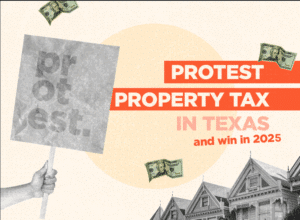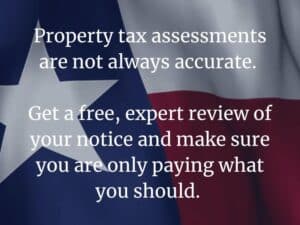Property taxes are a significant expense for homeowners, business owners, and real estate investors, driven by the assessed value set by your county appraisal district. If this value exceeds your property’s fair market value—what it would sell for in a competitive market—you could be overpaying hundreds or thousands of dollars annually. Filing a property tax protest allows you to challenge an inflated assessment, but the process is fraught with pitfalls that can undermine your case. Making mistakes like missing deadlines or presenting weak evidence can cost you savings and lock in an unfair tax bill. This comprehensive guide highlights the most common mistakes to avoid in property tax protests, offering practical advice and expert tips to help you navigate the process successfully and maximize your tax savings.
Why Avoiding Mistakes Matters
A successful property tax protest can significantly lower your tax bill. For example, reducing a $500,000 assessment by $50,000 at a 2.5% tax rate saves $1,250 annually. However, errors in the protest process—such as missing the filing deadline or using unreliable data—can lead to rejections, missed savings, or even higher future assessments. By steering clear of these common mistakes, you can build a strong case, meet critical deadlines, and secure a fair valuation.
Top Mistakes to Avoid in Property Tax Protests
These are the most frequent errors property owners make when protesting their taxes, along with strategies to sidestep them:
1. Missing the Protest Filing Deadline
- What Happens: Appraisal districts set strict deadlines, typically May 15 or 30 days from the appraisal notice date. Missing this cutoff means you accept the assessed value, even if it’s inflated, until the next tax year.
- Why It’s Costly: You lose the chance to correct overvaluations or errors, potentially overpaying by thousands. For example, a $40,000 overvaluation at a 2.5% tax rate costs $1,000 annually.
- How to Avoid:
- Review your appraisal notice immediately upon receipt (mailed in spring, e.g., April 2025).
- Note the deadline (e.g., May 15) and set a calendar reminder for one week prior.
- File early, ideally within a week of receiving the notice, using the district’s online portal, mail, or in-person delivery.
- Example: Failing to file by May 15 for a $450,000 assessment (comps suggest $410,000) costs $1,000 extra yearly.
- Tip: File even if your evidence isn’t fully prepared, as you can add materials later. See our blog post, “Why Deadlines Matter in Property Tax Protests,” for more.
2. Using Weak or Irrelevant Comparable Sales (Comps)
- What Happens: Presenting comps that are outdated, too far away, or dissimilar (e.g., a condo vs. your house) weakens your case, as appraisers prioritize recent, nearby, similar sales.
- Why It’s Costly: Weak comps fail to prove your property’s market value is lower, leading to a denied protest and no reduction.
- How to Avoid:
- Select 3–5 sales within 6–12 months, as of the valuation date (often January 1).
- Choose properties within a half-mile, with similar square footage, age, bedrooms, bathrooms, and condition.
- Adjust for differences (e.g., subtract $10,000 if a comp has a pool).
- Source data from reliable places like MLS via a realtor or county sales records, not public sites like Zillow, which may be inaccurate.
- Example: Using a $400,000 comp from 18 months ago or 2 miles away gets dismissed, while three recent, nearby sales at $405,000–$415,000 support a $410,000 value vs. a $450,000 assessment.
- Tip: Include a table and map of comps to show proximity and relevance, as suggested in “Secrets to a Successful Property Tax Protest.”
3. Ignoring Property Condition Issues
- What Happens: Failing to document issues like structural damage or outdated systems misses an opportunity to justify a lower value compared to comps in better condition.
- Why It’s Costly: Appraisers assume your property matches comps, denying reductions for unproven defects, potentially costing hundreds in savings.
- How to Avoid:
- Identify high-impact issues (e.g., cracked foundation, 25-year-old HVAC).
- Take clear, timestamped photos labeled with dates and descriptions (e.g., “Roof damage, May 2025”).
- Obtain 1–2 repair estimates from licensed contractors on official letterhead.
- Explain how issues reduce your property’s value (e.g., “My $15,000 roof repair lowers my value vs. comps”).
- Example: Not documenting a $12,000 HVAC replacement leads to a $430,000 assessment, while photos and an estimate secure a $415,000 value, saving $375 yearly.
- Tip: Focus on costly, buyer-noticeable issues over minor cosmetics, as they have greater impact, per Texas Tax Protest’s evidence tips.
4. Overlooking Appraisal Errors
- What Happens: Errors in the district’s records (e.g., wrong square footage, extra bedrooms) inflate your assessment, and failing to correct them misses an easy reduction opportunity.
- Why It’s Costly: Uncorrected errors can add tens of thousands to your value, increasing taxes now and in future years.
- How to Avoid:
- Review your property record on the district’s website or notice for details like square footage, lot size, and features.
- Compare to your deed, survey, or blueprints.
- Provide proof (e.g., a survey showing 2,300 sq ft vs. 2,500 sq ft) to the district or include in your protest.
- Example: Ignoring a 200-square-foot overstatement at $150 per square foot costs $30,000 in value, or $750 yearly at a 2.5% tax rate.
- Tip: Request a field inspection if you suspect undocumented errors, as appraisers may rely on outdated data.
5. Presenting Disorganized or Excessive Evidence
- What Happens: Submitting a chaotic packet or overloading with 10+ comps, irrelevant data, or unorganized photos confuses appraisers and ARB members, who have limited time (5-7 minutes per case).
- Why It’s Costly: Disorganized evidence dilutes your argument, reducing the chance of a reduction.
- How to Avoid:
- Compile a concise binder or digital folder with:
- A one-page summary proposing your value (e.g., “I request $400,000 based on comps”).
- 3–5 strong comps in a table with adjustments.
- Photos and repair estimates with clear labels.
- A map showing comps’ locations.
- Optional unequal appraisal data (similar properties with lower assessments).
- Use simple visuals (e.g., charts, highlighted maps) to emphasize key points.
- Bring extra copies for the appraiser, ARB, and your records.
- Compile a concise binder or digital folder with:
- Example: A messy packet with 12 comps and unlabeled photos fails, while a binder with three comps and a $10,000 repair estimate secures a $40,000 reduction from $440,000.
- Tip: Keep your summary to one page and lead with your strongest evidence.
6. Relying on Emotional or Non-Data-Driven Arguments
- What Happens: Arguing “My taxes are too high!” or “I can’t afford this!” without evidence is dismissed, as appraisers and ARBs focus on market value and data.
- Why It’s Costly: Emotional pleas waste time and undermine credibility, leading to no reduction.
- How to Avoid:
- Base your case on objective evidence: comps, condition issues, errors, or unequal appraisals.
- Present calmly and factually (e.g., “My comps show a $410,000 value vs. $450,000”).
- Avoid personal financial arguments, as they’re irrelevant to valuation.
- Example: Complaining about tax affordability fails, while three comps at $405,000–$415,000 secure a $410,000 value, saving $1,000 yearly.
- Tip: Practice a 5–7 minute data-driven presentation to stay focused during reviews.
7. Skipping the Informal Review
- What Happens: Bypassing the informal review with an appraiser and going straight to the ARB hearing misses a chance to resolve the protest quickly and easily.
- Why It’s Costly: Informal reviews often yield reductions without the formality of an ARB hearing, saving time and effort.
- How to Avoid:
- Schedule the informal review (in person, phone, or online) after filing your protest.
- Present your strongest evidence in 5-7 minutes, focusing on comps or errors.
- Be open to negotiation, as appraisers have authority to adjust values.
- Example: Skipping the informal review delays a $420,000 assessment reduction to $400,000, which could have been settled in May vs. a June ARB hearing.
- Tip: Use the informal review to gauge the appraiser’s perspective, strengthening your ARB case if needed.
8. Not Verifying Exemptions
- What Happens: Failing to check or apply for eligible exemptions (e.g., homestead, senior, disabled veteran) increases your taxable value, costing savings.
- Why It’s Costly: A $50,000 homestead exemption on a $400,000 home at a 2.5% tax rate saves $1,250 yearly, missed if not claimed.
- How to Avoid:
- Review your notice for applied exemptions.
- Check eligibility on the district’s website (e.g., homestead for primary residences).
- Apply by the deadline with required documents (e.g., proof of residency).
- Example: Not applying for a homestead exemption costs $1,250 yearly, while claiming it during a protest saves immediately.
- Tip: Apply for exemptions right after buying a home or becoming eligible, as noted in “Navigating Your County Appraisal District.”
9. Underestimating the ARB Hearing
- What Happens: Arriving unprepared or unrehearsed for the formal ARB hearing weakens your case, as the independent board expects a concise, evidence-based presentation.
- Why It’s Costly: A poor presentation risks losing a winnable reduction, missing savings like $1,000 for a $40,000 cut.
- How to Avoid:
- Prepare a 5–7 minute presentation summarizing your evidence (e.g., “My comps show $400,000”).
- Use visuals like comp tables, repair photos, or maps.
- Practice with a timer and anticipate questions (e.g., “Why are these comps relevant?”).
- Bring extra evidence copies for the ARB and appraiser.
- Example: A rehearsed presentation with three comps and a repair estimate secures a $45,000 reduction from $460,000, while an unprepared one fails.
- Tip: Stay calm and factual, avoiding arguments with the ARB.
10. Not Following Up After the Protest
- What Happens: Failing to verify the new value or save evidence risks errors in your tax bill or unpreparedness for future protests.
- Why It’s Costly: An unapplied reduction or recurring issues cost savings, while saved evidence simplifies next year’s protest.
- How to Avoid:
- Check the district’s website or decision letter to confirm the new value.
- Contact the district if errors persist.
- Save your evidence packet (comps, photos) for future use.
- Monitor next year’s notice for recurring issues.
- Example: Not verifying a $30,000 reduction leads to a $450,000 tax bill instead of $420,000, costing $750 yearly.
- Tip: Apply for exemptions post-protest to maximize savings, as suggested in “Property Value Notices Are Out.”
Real-World Example
Consider Sarah, whose home is assessed at $470,000, but she believes it’s worth $425,000. She avoids common mistakes:
- Files on Time: Submits her protest by April 20, well before the May 15 deadline, avoiding a missed opportunity.
- Uses Strong Comps: Selects three recent, nearby sales at $420,000–$430,000, adjusted for features, instead of old or distant comps.
- Documents Condition: Includes photos and a $12,000 roof repair estimate, strengthening her case.
- Corrects Errors: Provides a survey fixing a 2,600 sq ft record to 2,400 sq ft, worth $30,000.
- Organizes Evidence: Presents a binder with a summary, comp table, and visuals, avoiding clutter.
- Stays Data-Driven: Focuses on comps and repairs in the informal review, not emotions, securing a $45,000 reduction to $425,000, saving $1,125 at a 2.5% tax rate.
- Verifies Exemptions: Applies for a homestead exemption, saving another $1,250.
- Follows Up: Confirms the new value online, ensuring her tax bill reflects the reduction.
Sarah’s diligence saves $2,375 annually and prepares her for future protests.
Why Avoiding These Mistakes Is Critical
Avoiding these common mistakes ensures your property tax protest is timely, evidence-based, and persuasive, maximizing your chances of a reduction. Missing deadlines, using weak comps, or presenting disorganized evidence can cost you significant savings and lock in overvaluations. By following these strategies, you align with the appraisal district’s valuation methods, leveraging objective data (comps, errors) and clear presentations to secure a fair tax bill. A successful protest not only saves money this year but also sets a precedent for future assessments, compounding your savings.
Taking the First Step
Start by reviewing your appraisal notice for the assessed value, errors, exemptions, and protest deadline (typically May 15 or 30 days from the notice). File your protest early using the district’s form, available online or by request. Gather strong evidence, 3–5 comps from MLS or county records, photos of property issues, and proof of errors, and organize it in a concise packet. Submit by the deadline, prepare a data-driven presentation, and verify exemptions and outcomes. For complex cases, consider a property tax consultant to avoid pitfalls and enhance your case.
For specific details, search online for the Appraisal District or contact their office for forms, deadlines, and resources. Avoid these common mistakes to ensure a successful property tax protest and keep your tax bill fair.
Disclaimer: Property tax laws and procedures vary by state and county. Always verify local rules with your appraisal district or a qualified professional. This guide is for informational purposes and does not constitute legal advice.






